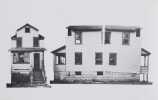MATTA CLARK GORDON (1943-1978)
Splitting
New York, 98 Greene Street Loft Press, 1974, 180x280mm, 32p., broché sous couverture souple titrée.Textes et 17 pages (dont une grande planche dépliante) d’illustrations photographiques.
Reference : 104813
L’artiste choisit ici de découper une maison abandonnée au 322 Humphrey Street, Englewood, New Jersey.Ref.:Gordon Matta-Clark, A Retrospective Museum of Contemporary Art, Chicago 1985 p. 112-121. Gordon Matta-Clark IVAM 1992 p.194-209. Moeglin-Delcroix p.256, reproduit.(104813) Très bon
Bookseller's contact details
Librairie Chloé et Denis Ozanne Déesse sarl
M. Denis Ozanne
21 rue Monge
75005 Paris
France
+33 1 48 01 02 37
Payment mode



Sale conditions
Conforme aux usages de la librairie ancienne et moderne, tous les ouvrages présentés sont complets et en bon état, sauf indication contraire. L'exécution des commandes téléphonées est garantie mais sans règle absolue, la disponibilité des livres n'étant pas toujours vérifiable lors de l'appel. Les frais de port sont à la charge du destinataire. Les livres sont payables à la commande. Nous acceptons les règlements par chèque bancaire ou postal, mandat postal ou international, carte bancaire, Visa, Eurocard, MasterCard et virements bancaires dans certaines conditions.
5 book(s) with the same title
Rasshcheplenie zhirov i poluchenie glitserina. In Russian /Fat splitting and ...
Short description: In Russian. Petrov, Grigory Semenovich. Fat splitting and glycerine production. Leningrad: Scientific Chemical and Technical Publishing House, Scientific and Technical Proceedings V.S.N.H., 1928: type. Chemtekhizdite. Rasshcheplenie zhirov i poluchenie glitserina. In Russian /Fat splitting and glycerine production. Please feel free to contact us for a detailed description of the copies available. SKU9227504
Reference : alb403566638a14ab43
Poster: Splitting the lamb carcass. In Russian /Plakat «Razdelka baraney tushi»
Poster: Splitting the lamb carcass. In Russian /Plakat «Razdelka baraney tushi». Artist: V.N.Maksimov. Publisher: Moscow: Higher School 1990 Approved by the USSR State Committee for Public Education. 64x91 sm. We have thousands of titles and often several copies of each title may be available. Please feel free to contact us for a detailed description of the copies available. SKUalb403566638a14ab43.
 Write to the booksellers
Write to the booksellers


